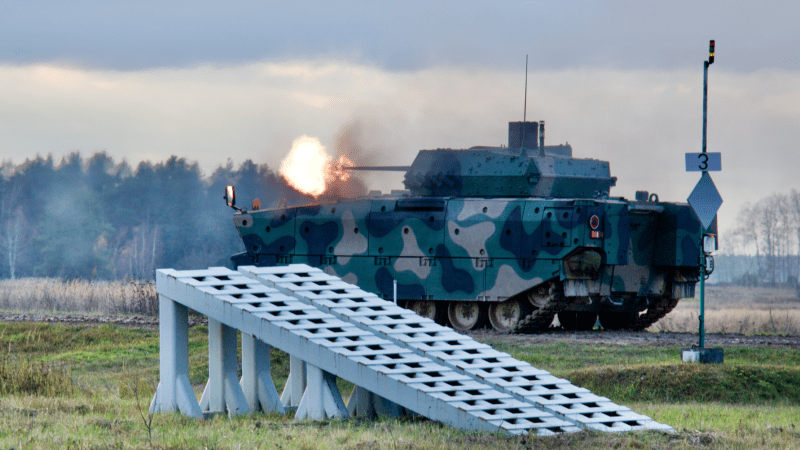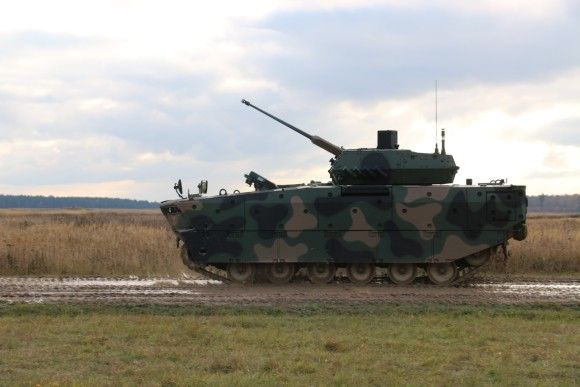Industry
Borsuk IFV - Qualification Tests Programme Launched [REPORT]

Wierzbiny MBT and Combat Vehicles Shooting range near Orzysz has been the venue where the Borsuk’s automatic cannon and coaxial machine gun were test-fired. The event was attended by Mariusz Błaszczak, head of the Polish MoD, among other officials. This marks the beginning of the first, main portion of the test programme related to the vehicle that is soon expected to be received by the Polish Armed Forces. The Borsuk IFV programme is scheduled to be in full swing throughout the year 2023.
The demonstration of the Borsuk IFV's capabilities was to emphasize the vehicle's engagement capabilities and highlight the differences between the new platform, and the legacy BWP-1. The demonstration commentary was provided to the Minister of Defence by the commander of the 15th "Giżycka" Mechanized Brigade, Brig. General Piotr Fajkowski. The element in question is the first one that would be receiving the new Borsuk vehicles. Fajkowski emphasized the fact that during a retreat, the vehicle does not need to expose its rear part to the adversary, thus it is continuously facing the enemy with the strongest, front armour. This has been made possible thanks to the camera system available to the driver, and high reversing speed. During the demonstration, Borsuk was engaging targets simulating threats typical for an environment in which an IFV would operate: APCs, enemy IFVs, reconnaissance vehicles, or ATGM posts.
The vehicle was using its 30 mm Bushmaster II gun, and the coaxial machine gun as well. To make everything more spectacular, numerous tracer rounds were used. According to statements made by the HSW employees, this has been the first situation in which Borsuk was engaging targets as if it was happening during a standard field training exercise, with targets having a lower height than during a state qualification, where accuracy and groupings are the primary factors that are being measured. Earlier on, just test firing had taken place at the range, 1 hour before the proper demonstration. The demonstration has seen the Borsuk face the deep end, but it also was quite successful. Consortium designers were the crew. The commander came from WB Electronics, while the role of the gunner was taken by a designer from HSW.

During the demonstration, it was emphasized Borsuk would also be outfitted with Spike ATGMs. When it comes to the cannon itself, its effective range is defined as 2.5 - 3 kilometres, three times what was offered by the obsolete, legacy BWP-1 gun (1 kilometre). General Fajkowski stressed the importance of that in modern warfare. "As the experience gathered during the recent conflicts has shown, knowing that the enemy uses a vehicle with a short range of fire, the attacker is making attempts not to enter that range. They retreat, effectively engaging the enemy staying outside of their effective engagement range. We have seen this ever since the Gulf War when the US elements adopted such a set of tactics. A similar set of tactics was being employed by the Polish elements during the Afghan deployment", Fajkowski said.
General Fajkowski also emphasized the fact that Borsuk has a fully digital fire control system at its disposal, with independent optoelectronic units available to the commander, and the gunner. This allows for “hunter-killer” operations - the commander searches for and designates the targets, while the gunner only engages them. Thanks to the availability of HE and sabot rounds, the Bushmaster gun allows the vehicle to engage all types of land targets, MBTs included, provided that rear or side armour can be hit.
Testy bwp #Borsuk w Orzyszu 🇵🇱💪💥 @Defence24pl pic.twitter.com/MKodCqyItF
— Mateusz Mitkow (@MitkowMateusz) November 14, 2022
Mariusz Błaszczak, head of the Polish Ministry of Defence, announced that after the successful completion of the test programme, a framework agreement concerning the Borsuk IFVs would be signed. The procurement plan exceeds 1,000 examples. "This would be one of the largest contracts, concluded with the Polish defence industry", he emphasized. Błaszczak said that the Borsuk IFVs, alongside the K2 main battle tanks, would first be received by the 16th Mechanized Division, and the 15th Mechanized Brigade.

The Spokesperson for the Armament Agency, Lt. Col. Krzysztof Płatek added that the qualification test programme has been divided into two stages, whereas the one happening now is the primary one, as it involves the verification of the vehicle specification in the defence norms area. This includes offroad and amphibious capabilities, engagement capabilities, and ballistic/mine/IED protection levels. The tests are scheduled to happen over the upcoming few months, and it is planned they would be completed by mid-2023. If everything goes according to the plan, then, framework agreement negotiation would begin, regarding the acquisition of "more than 1,000 vehicles". This would be tied to the expansion of the Armed Forces structure, regardless of the fact that the 18th Mechanized Division is expected to feature a heavy component with Abrams MBTs, with a possible scenario in which that unit also receives heavier IFVs. The heavier IFVs, probably from Korea, would only be used by the 18th Division, while the remaining units would be operating the Borsuk IFV.
The second stage of the test programme is to have a complementary nature and allow for verification of the ICT systems, and verification of the vehicle's capability to work with other units - also when it comes to data exchange capabilities. The spokesperson for the Armament Agency also said that this is not the key stage of the test programme. The manufacturer is encouraged to boost his manufacturing output, to deliver the vehicles for the Armed Forces as urgently as possible.

Apart from the Borsuk IFV, numerous specialized variants are expected to be developed, not being a part of the aforesaid batch of vehicles. They would be procured separately. The development effort on these has already been launched at HSW S.A. The goal is to create command, reconnaissance, support, or even ARV platforms.
As the HSW S.A. employees claim, a detailed schedule for the first, and the most important stage of the test programme would be devised in late November, when the Qualification Tests Commission assembles, and when talks are initiated, involving the Military Institute of Armoured and Automotive Technology (WITPiS). Then, the process would be accelerated. Between the 28th and 30th of November further, live, test fire events have been planned to happen at the range in Nowa Dęba. The first test firing event is to involve a default, not-confidential turret configuration, while later on, the "restricted" turret would be used, fitted with the target specification C2 and ICT systems. EM compliance of all hardware would need to be checked as well.

Currently, the Borsuk prototype showcased on 14th November exists, along with an experimental prototype support vehicle. Four pre-production vehicles are being manufactured now, destined for the Polish Armed Forces: One command vehicle, and three standard IFVs. As we have found out, the base platforms have already been welded, with hulls expected to be assembled by the end of the year.
Borsuk IFV is a modern tracked vehicle designed for mechanized infantry elements. The crew consists of a commander, a gunner, and a driver. The vehicle is amphibious, which is unique in its class. Borsuk offers the crew and the troops inside protection from small arms fire, anti-tank grenade launchers, and IED/mines. The vehicle can travel at a top speed of 65 kph on hardened surfaces, and it can attain speeds of up to 8 kph in an amphibious setting. Borsuk weighs 28 tonnes in its base variant.
The Borsuk design has been created by a consortium led by HSW S.A., and involving the entities as follows: Ośrodek Badawczo-Rozwojowy Devices Mechanicznych OBRUM Sp.z o.o., Wojskowe Zakłady Motoryzacyjne S.A. (Military Automotive Works), ROSOMAK S.A., Military Electronic Works S.A., War Studies University, Military University of Technology, Wojskowy Instytut Techniki Pancernej i Samochodowej (Military Military Institute of Armoured and Automotive Technology) and Warsaw University of Technology.
